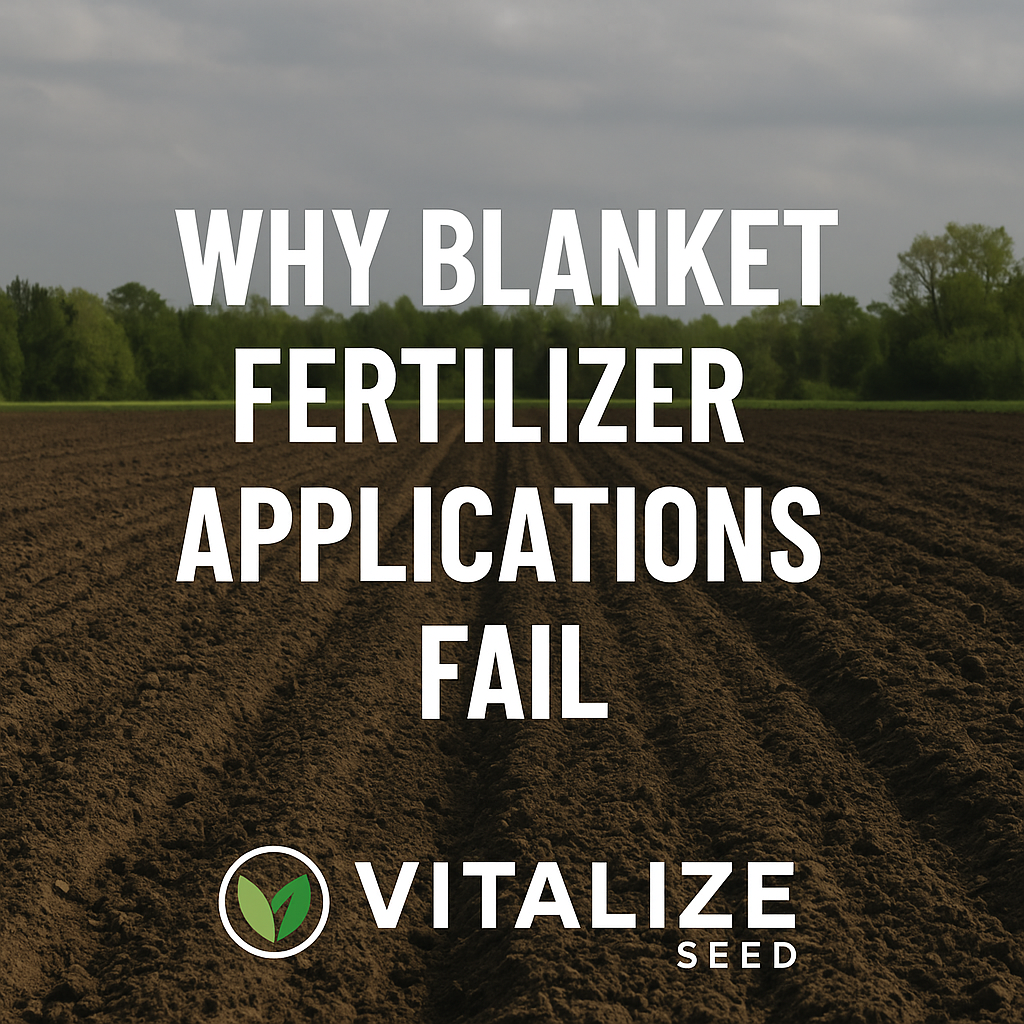
The Hidden Cost of Blanket Fertilizer Applications: Why Uniform Nutrient Programs Fail Your Soil
Share
The Illusion of “Balanced” Fertility
For decades, uniform fertilizer blends have been marketed as an all-in-one solution. The problem is that true soil balance isn’t found in a bag. It is created through the relationship between pH, cation exchange capacity (CEC), base saturation, organic matter, and biology.
When you broadcast equal parts nitrogen, phosphorus, and potassium across a field, food plot, lawn, or garden, you’re assuming every soil particle and plant root has the same need. In reality, soils are dynamic systems. Some zones already have high P or K saturation, others are calcium-deficient, and almost all benefit more from carbon and biological activity than from additional synthetic salts. This becomes especially problematic when applying hundreds of pounds per acre without data and in a broadcasted method.
Why Blanket Applications Fail
Uniformly spreading fertilizer or manure might feed the crop in the short term, but it often harms the soil in the long term. Here’s why:
-
Phosphorus Stratification: Surface applications without incorporation lead to heavy P build-up in the top inch of soil, while the root zone below becomes deficient. This results in shallow rooting and poor drought tolerance.
-
Runoff and Waste: When phosphorus sits on the surface and soil is eroded, the phosphorus moves with it. Potassium and nitrogen, being more mobile, can leach rapidly through the soil before plants can absorb them. This isn’t just bad for the environment, it’s bad for your checkbook.
-
Chemical Tie-Up: Phosphorus reacts readily with calcium, iron, and aluminum depending on soil pH. In neutral to high pH soils, it binds with calcium; in acidic soils, it binds with iron and aluminum. These reactions form insoluble compounds that make P unavailable to plants.
-
Biological Imbalance: High rates of salt-based fertilizers can suppress beneficial microbial activity and disrupt natural nutrient cycling. This limits organic matter turnover, reduces nitrogen fixation, and slows carbon building.
To make matters worse, when you try to reach a specific soil test goal for one nutrient using a “complete” fertilizer blend, you almost always overapply the others. For example, if your soil test calls for 30 pounds of phosphorus per acre and you use a 13-13-13 fertilizer to reach that number, you’ll also apply roughly 30 pounds each of nitrogen and potassium whether they’re needed or not. Those excess nutrients can create imbalance, drive antagonism, or leach away entirely.
This problem is even more pronounced with synthetic fertilizers, which are highly soluble and either rapidly mobile (as with nitrogen and potassium) or prone to quick surface tie-up (as with phosphorus). In contrast, mismanaged manure applications can also create antagonism and buildup issues, but they do so more gradually due to slower release and partial biological buffering. Regardless of source, blanket applications without soil data still create long-term imbalances that reduce nutrient efficiency and biological stability.
The Overlooked Issue: Nutrient Antagonism
Even when tillage is used to move nutrients deeper into the soil, blanket applications can create complex antagonisms that limit uptake and plant health.
Phosphorus is one of the biggest culprits. When P levels climb too high, it interferes with zinc and copper uptake, leading to hidden deficiencies that appear as slow growth or poor vigor. Too much nitrogen relative to sulfur results in an imbalance of amino acid and protein formation, leading to soft tissue growth and weak root systems. When calcium and magnesium are out of proportion, soil structure suffers, affecting aggregation and oxygen exchange.
Over time, these imbalances reduce soil tilth, which refers to the combination of structure, porosity, and workability that determines how well air, water, and roots move through the soil. Once tilth declines, infiltration slows, compaction increases, and nutrient efficiency collapses.
The solution isn’t more fertilizer, it’s precision guided by a soil test.
The Nitrogen Problem We Don’t Talk About
The same story plays out with nitrogen, especially when urea or other fast-release sources are broadcast without understanding rates, timing, or placement. Most synthetic nitrogen sources are volatile, and even organically derived N becomes mobile once microbes convert it to nitrate.
If applied to dry soil or under warm, windy conditions, urea can convert to ammonia gas, which is readily lost to the atmosphere. That is wasted dollars gone before the plant ever sees them. Over-application of nitrogen without balancing calcium and sulfur can also acidify soil, displacing calcium from exchange sites and tightening soil structure. The result is more compaction, reduced infiltration, and weaker microbial activity.
When nitrogen, sulfur, and calcium are in balance, microbes help convert N into amino or organically complexed forms that are more stable and less prone to loss. This is the foundation of REGEN-N+™, which provides amino-acid nitrogen that resists volatilization while feeding beneficial microbes that hold nutrients in the soil profile.
The Manure Myth
Manure can be a valuable input, but it’s far from balanced. Most livestock manure contains far more phosphorus and potassium than nitrogen or sulfur. Over time, repeated applications build up P to excessive levels.
As phosphorus climbs, calcium and sulfur availability decline. The soil begins to “lock down,” and even with good organic matter, nutrient uptake efficiency drops sharply. These conditions also drive nutrient antagonisms and further imbalance, often showing up as hidden deficiencies or limited biological activity despite seemingly “fertile” soil. You may see lush top growth early, but roots and yield suffer later.
If using manure, I highly recommend a manure analysis before application. This allows you to understand the actual pounds of nutrients you’re applying in both organic and inorganic forms. Just like a soil test, this data ensures nutrients are applied accurately and balanced correctly to prevent excess buildup, antagonism, and wasted fertility potential.
The Role of Placement and Carbon
Efficient fertility comes from proper placement and carbon synergy. Nutrients must be delivered where roots and microbes can access them, not sitting on the surface waiting for runoff.
Carbon acts as the bridge between chemistry and biology. No-Till Nurture™ provides a balanced, manure-derived source of organic carbon and nutrients, naturally stabilized for slow, steady release. The phosphorus moves through the soil biologically, while nitrogen and potassium move more gradually, reducing the risk of volatility and leaching.
Products like Bio-Charge™ further enhance this process by supplying humic and fulvic acids that chelate nutrients and keep them plant-available. Paired with Revive RX™ and REGEN-N+™, this creates a sustainable system that supports soil biology and nutrient cycling throughout the growing season.
Soil tests remain critical to ensure your system stays balanced. Regular testing helps verify micronutrient levels, pH, base saturations, and overall fertility trends.
Vitalize MICROS™ and the Power of Balance
Rather than blanket applications, Vitalize MICROS™ delivers a precise spectrum of sulfur, calcium, and micronutrients that support balanced cation ratios and improved phosphorus mobility.
When combined with No-Till Nurture™, the result is slow-release fertility that enhances both chemical and biological balance, a foundation for healthy, sustainable soils.
From Runoff to Regeneration
Soil health is not about how much you apply; it’s about how efficiently the system recycles what’s already there. By feeding biology, balancing chemistry, and managing placement, you turn short-term inputs into long-term fertility.
The Vitalize One-Two System (NitroBoost™ and Carbon Load™) was built around this principle. By alternating high-carbon and high-nitrogen covers, the system naturally mines, stores, and recycles nutrients over time. This reduces dependence on external fertilizers while improving structure, microbial activity, and nutrient density.
The Takeaway
Before reaching for a blanket fertilizer or another load of manure, take a step back and look at your soil test. Ask:
-
What is my phosphorus level in ppm?
-
What are my base saturations?
-
What is my soil CEC? (This determines best nutrient timing and planting methods.)
Vitalize Seed’s system focuses on targeted nutrition, biological activation, and carbon integration. Because when you feed the soil correctly, you don’t just grow better plants, you build better ground.
